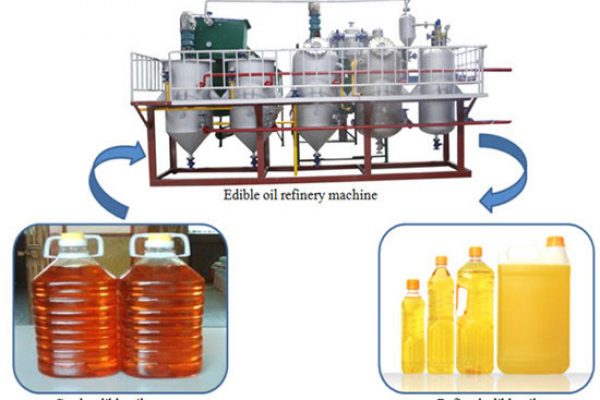Introduction
Project report for Edible Oil Refinery is as follows.
It is a method of purifying and refining crude oils into clean, nutritious oils fit for human use. Unwanted contaminants in crude oil are eliminated throughout the refining process, leaving behind a high-quality product that passes food safety regulations. Several phases are involved in the refining process, including degumming (removing phospholipids), neutralisation (removing free fatty acids), bleaching (removing colours), and deodorization (removing odours).
This increases the shelf life of the oil while also improving its flavour and nutritional value by eliminating any hazardous ingredients. Edible oil refineries are an important aspect of the food business since they assist to guarantee that we have clean and safe cooking oils that can be used in a variety of common kitchen applications such as frying, baking, and salad dressing recipes.

Benefits Of Edible Oil Refinery
Impurity Removal: Edible oil refineries successfully remove impurities, pollutants, and unwanted components found in crude vegetable oils. This contains free fatty acids, gums, phospholipids, pigments, waxes, and volatile chemicals that cause off-flavors and odours. The elimination of these contaminants improves the oil’s look, flavour, and stability.
Food Safety And Quality: Refining edible oils guarantees that they fulfil severe food safety regulations. Toxins, pesticides, heavy metals, and microbiological pollutants are removed throughout the process, making the oils safe to consume. Edible oil refineries also increase the oil’s quality by minimising rancidity, prolonging shelf life, and preserving nutritional content.
Enhanced Flavour And Aroma: Edible oil refineries contribute to establishing a neutral flavour profile by eliminating unwanted components and refining the oil. This allows the cooking oils’ inherent flavours and smells to come through, increasing the flavour of diverse foods made with these oils.
Increased Stability: Refining methods such as degumming, bleaching, and deodorization increase edible oil stability. The removal of gums, colours, and volatile substances helps to avoid oxidation and rancidity, which can result in the development of damaging free radicals. Refined oils have a longer shelf life and are less likely to deteriorate, allowing customers to keep and utilise them for a longer period of time.
Market Potential Of Edible Oil Refinery
The edible oil market was valued at USD 91.18 billion in 2021 and is predicted to be valued at USD 174.81 billion by 2030, growing at a 7.5% CAGR between 2023 and 2030.
Edible oils, a source of vital fatty acids obtained from plant, animal, or synthetic fat, are used in frying, baking, and other types of cooking/food preparation. Edible oil is also defined as “a food material, excluding a dairy item, of whatever source, origin, or composition that is made for human consumption in part or entirely from fats, excluding milk.” These are also employed in a variety of food preparations and flavorings that do not use a heat source, such as salad dressings and bread dips.
The cooking medium’s content and physicochemical qualities alter as a result of extraction, refining, and processing during various food preparations. With the rising need for healthier cooking options, edible oil refineries play a key role in meeting this demand by producing high-quality oils that respond to changing customer preferences for better food options.
Edible oils include trace levels of antioxidants that prevent antioxidation. Antioxidants are also utilized to extend the shelf life of edible oils. However, only suitable quantities of antioxidants should be provided. As a result, the oil should be carefully chosen in order to fulfill its special property.
Edible oils are one item that is susceptible to many forms of adulteration. The most well-known oil adulterants include cheaper oils that degrade oil quality, as well as other non-edible oils or compounds such argemone oil, tricresyl phosphate, and butter yellow.
The rise in disposable income is the key growth driver in the Global Edible Oil Market. Because of a solid supply chain of edible oil products and an established retail chain, the retail industry is likely to drive edible oil sales. Vegetable oil consumption has increased in emerging countries due to rising demand from a growing population, a thriving retail sector, and an increase in overall household income.
Furthermore, edible oil makers are implementing innovative processing procedures in order to provide healthier and more economical oil. However, they fall short of meeting incoming demand for edible oil.
Project Report Sample On Edible Oil Refinery
Need Help?
Create 100% Bankable Project Report

